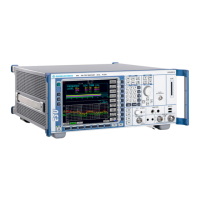Operating Manual 1302.6163.12 - 03 4.119
R&S ESU Instrument Functions
Analyzer Mode
MAIN PLL
BANDWIDTH
The MAIN PLL BANDWIDTH softkey defines the bandwidth of the main PLL of the
analyzer synthesizer and thus influences the phase noise of the analyzer. Three
bandwidth settings are possible (High / Medium / Low); if AUTO is selected, the
bandwidth is set automatically (default).
Remote command: BAND:PLL AUTO
FFT FILTER
MODE
The softkey FFT FILTER MODE allows to specify between the following three
options for FFT filters:
Remote command: SENS:BWID:FFT WIDE | AUTO | NARR
VBW MODE
LIN | LOG
The VBW MODE LIN/LOG softkey determines the position of the video filter in the
signal path for resolution bandwidths ≤ 100 kHz:
• If LINear is selected, the video filter will be in front of the logarithmic amplifier
(default).
• If LOGarithmic is selected, the video filter will be behind the logarithmic amplifier.
The essential difference between the two operating modes relates to the settling in
case of falling signal edges:
With LINear, the falling signal edge will be "flatter" than with LOGarithmic.
This is due to the conversion from linear power to logarithmic level units: a reduction
of the linear power by 50% reduces the logarithmic signal level by only 3 dB.
This is important for EMI measurements above 1 GHz. Below 1 GHz, CISPR 16-1-1
defines the linear average detector only. Above 1 GHz both, the linear and the loga-
rithmic average detector may be specified in product standards. Some standards
(e.g. ANSI C63.4:2000) require the linear average detector, whereas microwave
oven measurements may be made with the log average detector. CISPR 11 speci-
fies weighted measurements with a VBW of 10 Hz.
Fig. 4.2 shows the response of the linear and the logarithmic average detector for
pulse-modulated signals.
WIDE: The FFT filters with the greater partial span (this is the span which is
covered with one FFT analysis) are used always.
AUTO: The firmware decides whether to use wide or narrow filters to achieve
the best performance of the measurement.
NARROW: The FFT filters with the smaller partial span are used, this allows mea-
surements near a carrier with reduced reference level, because of a
more narrow analog prefilter.

